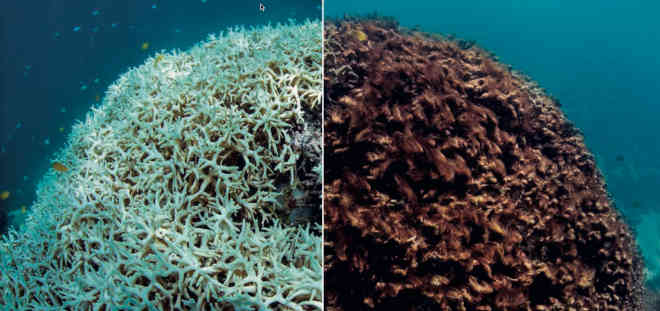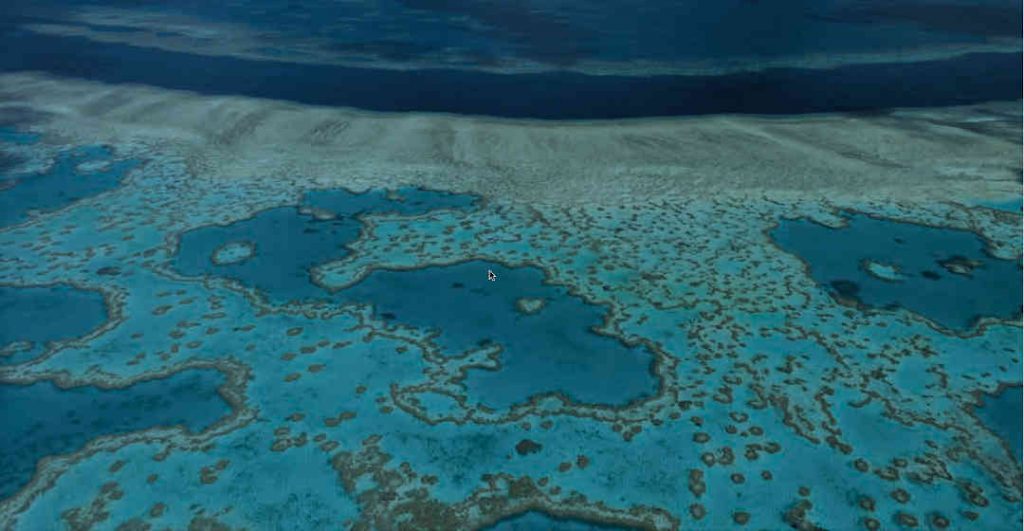Australia’s Great Barrier Reef includes about a tenth of the world’s coral reefs. Coral reefs play on important part in ocean ecology. But they are under threat.
Here’s a quick summary.
The Great Barrier Reef’s importance
The Reef is important ecologically.
Coral reefs are important parts of the ocean ecology. They harbour the highest biodiversity of any of the world’s ecosystems, including fish, invertebrates, plants, sea turtles, birds, and marine mammals. About 25% of the ocean’s fish depend on healthy coral reefs.
The Great Barrier reef is unique in the world. It is the largest coral reef system in the world, about 2,300 km long and covering almost 350,000 square km. It is so long it extends over 14 degrees of latitude, from shallow estuarine areas to deep oceanic waters, and this contains an enormous number of ecological communities, habitats and species (600 types of soft and hard corals, more than 100 species of jellyfish, 3000 varieties of molluscs, 500 species of worms, 1625 types of fish, 133 varieties of sharks and rays, and more than 30 species of whales and dolphins).
All of this makes the Reef one of the most complex natural ecosystems in the world.
It is a tourism asset
In a normal (non-Covid) year, 2-3 million people (half of them Aussies) visit the Reef. These visitors support nearly 60,000 jobs and contribute almost $6bn to the Australian economy.
It provides other benefits
Coral reefs can reduce coastal erosion, they support commercial fisheries and they can even be a source of new medicines. Economists value the reef at $56bn.
Threats to the Reef
Like other coral reefs, the Great Barrier Reef faces natural threats such as storm damage and disease. Human threats include agricultural pollution, sedimentation from land eropsion and unsustainable fishing practices.
Agricultural chemicals such as pesticides and herbicides can inhibit the growth of important seagrasses which are important for several species of marine life. Fertilisers can encourage algal growth and thus provide a food source for the destructive crown-of-thorns starfish.
Sediment runoff from agricultural land and river banks can smother coral and reduce the light reaching seagrasses.
The threat of climate change
Climate change is a relatively new threat to the reef, and one that could totally destroy it if global warming isn’t reduced.
As more of the sun’s heat is trapped by the increased carbon dioxide in the atmosphere, the earth’s temperature is rising. Much of this heat is stored in the oceans, raising the water temperature. Warmer water stresses coral, causing “coral bleaching” – stressed corals release colourful micro-algae, thus becoming white. In 2017, after several years of unusually warm water (partially associated with a strong El Niño), about two thirds of the Reef experienced bleaching.
Corals can recover from bleaching events if they have time, but as climate change continues, there will be insufficient time to allow recovery. And if global average temperatures increase by more than 2°C (which will occur unless stronger action is taken globally), coral reefs, including the Great Barrier Reef, will not survive.
In addition, about a third of the increased carbon dioxide in the atmosphere is absorbed by ocean water, making it more acid – a 30% increase in acidity in the past two centuries. This acidity causes fewer carbonate ions to be available to corals and shellfish, thus inhibiting growth and, in the extreme, even dissolving shells. Acidification also affects other sea creatures and seagrasses.

The future of the reef looks bleak
The current trajectory of climate action (or inaction) would lead to a global temperature rise of more than 2°C, which is enough to eventually destroy the Great Barrier Reef.
UNESCO (United Nations Educational Scientific and Cultural Organisation) encourages “the identification, protection and preservation of cultural and natural heritage around the world considered to be of outstanding value to humanity.” The Reef is on the World Heritage list as “a globally outstanding and significant entity”.
In June, UNESCO’s scientific advisors recommended adding the Reef to the ‘in danger’ list, because of the threat from climate change. Instead of welcoming the warning that a great natural asset was in danger and resolving to act on it, Australian Environment Minister Sussan Ley lobbied against the “in danger” assessment, and convinced enough other countries to support a deferral until 2022, when Australia will present a report on the Reef. Environmental organisations were upset with this action.
If the past is any indication ….
It seems unlikely that the present Government will act in any decisive and constructive way. Consider the past …..
- Australia is ranked last of almost 200 UN member countries for effective climate action. Our record on refusing to commit to net zero emissions, despite all the advantages Australia has to produce cheap renewable energy, is shameful.
- In 2018 the Government granted $444m to a small charity (The Great Barrier Reef Foundation) via a secretive process which the Government’s own Auditor-General said was “based on advice that failed to comply fully with rules designed to ensure transparency and value for money”. It could instead have chosen the much larger and well-equipped Great Barrier Reef Marine Park Authority. Critics said the Foundation Board was more representative of business interests that conservation interests. This left the suspicion that the government was more interested in protecting itself from criticism than in protecting the Reef.
- The Government is still approving new coal mines. Environment Minister Sussan Ley has approved extension to three mines in the last month. The Bravus (formerly Adani) mine near the Reef is proceeding.
Australia’s window to act is running out
Climate sceptics often argue that climate activists are exaggerated doomsayers, predicting “extinction” of the human race. I’ve never heard a reputable climate scientist or activist making such a foolish claim, but it is likely that some climate activist claims are indeed exaggerated.
But the possible destruction of the Great Barrier Reef within the lifetime of some people is not, apparently, a fanciful and alarmist claim, but based on the realistic prediction that global temperatures could raise far enough to make the Reef unviable.
Our Government is playing games with that unacceptable future.
References
- Decade of climate breakdown saw 14 per cent of coral reefs vanish. UN News, October 2021.
- Coral reef ecosystems. National Oceanic and Atmospheric Administration.
- Reef facts. Great Barrier Reef Marine Park Authority.
- Great Barrier Reef ‘too big to fail’ at $56b, Deloitte Access Economics report says. ABC News, June 2017.
- Pollution in the Great Barrier Reef. Fight for our Reef.
- Great Barrier Reef in Danger Zone. Climate Council, June 2021.
- In Pictures: a close-up look at the Great Barrier Reef’s bleaching. Climate Council.
Top photo: Great Barrier Reef, KConnors on MorgueFile.
Other photos: Climate Council (used with permission).

